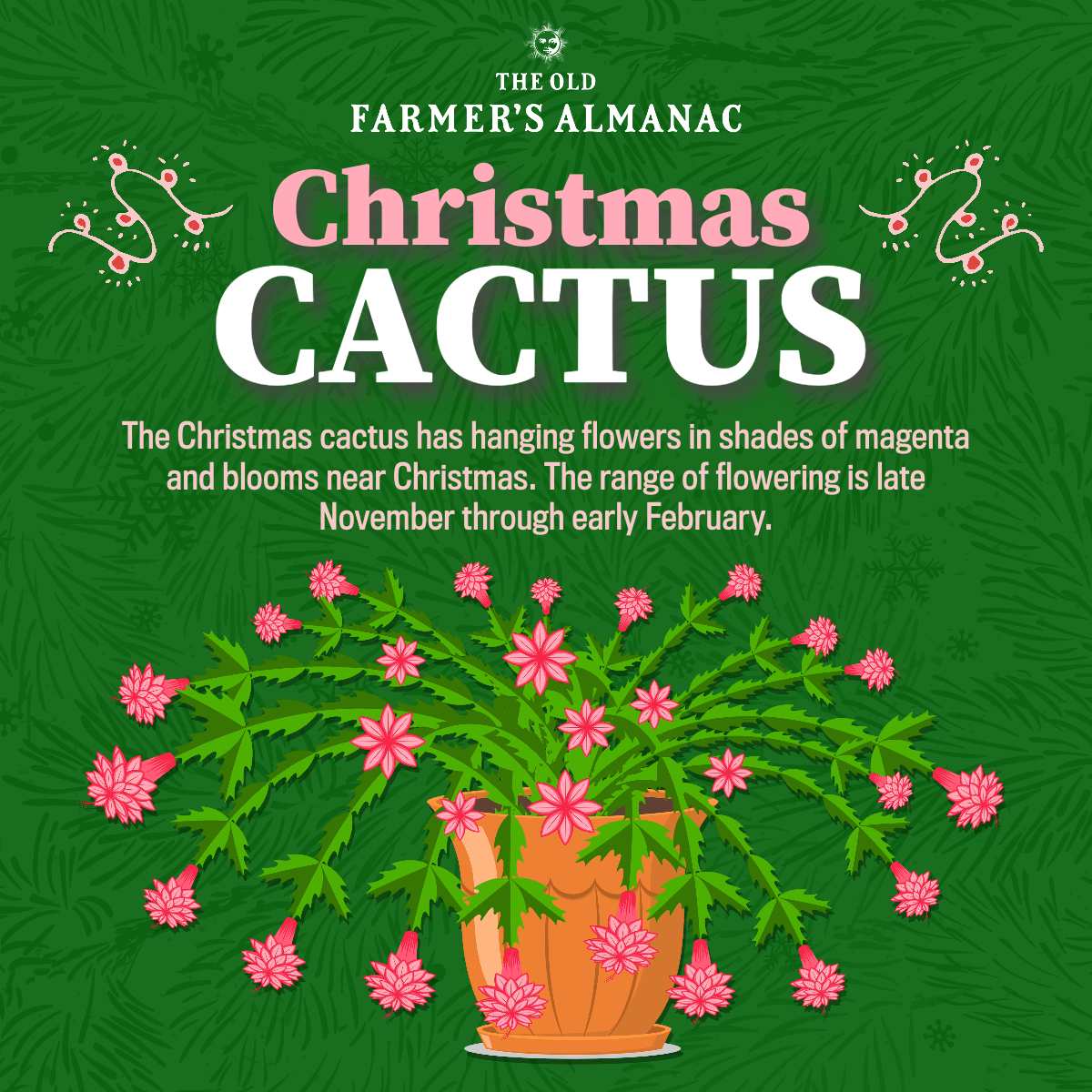
Growing Christmas Cactus Plants: Watering, Light, Propagation, and More!
The Almanac Garden Planner - Use It Free for 7 Days!
Plan your 2025 garden with our award-winning Garden Planner.
There are three main types of “holiday cacti” available:
- Thanksgiving cacti (Schlumbergera truncata) bloom from late fall to midwinter and are often mislabeled as Christmas cacti.
- Christmas cacti (S. x buckleyi) bloom from early winter to midwinter.
- Easter cacti (S. gaertneri) bloom from later winter to mid-spring.

ADVERTISEMENT
My Christmas cactus is probably 80 years old or more. It was my grandmothers, my mothers and now mine. It's a little late for blooming it;s buds are just popping out and are turning red. I have had it for maybe 10 years and have never added any fertilizer. There have been a few years that there was no flowers. I moved it into the garage a few years ago it seems to like it there.
My Christmas Cactus is 46 years old and blooms from Christmas until Easter. I have repotted over the years as needed. It is now in a large pot (the largest pot the Greenhouse has. Last year it had only a few blossoms??? This year it did not bloom at all???? I use plant food when I water it. It has been afew years since I have trimmed it. I will trim early spring. I wonder if it is root bound?? I do not want to loose this cactus that belonged to my mother in law.
Do you have any advise for me?
We have 3 what we have taken to calling "Holiday Cacti" because they tend to bloom around Easter, before Thanksgiving, and around Christmas. We live in Louisville, KY so the days aren't considered extreme as far as light conditions. One is about 30 years old, one is about 20-25 years old, and the youngest I propagated in water almost 5 years ago. So why do they bloom so often without fertilizer or anything other than plain water and, shhh, being talked to?
It sounds like you have some happy plants! And the number one rule with happy plants is don’t make them unhappy! I’d be hesitant to change anything. If you want to feel more involved, you might mix in a mild, diluted houseplant fertilizer every few waterings, just to stay ahead of the curve. But again, if they appear happy, I’d be inclined to stay the course. You mentioned that they get talked to a bit… and I’m passing no judgement here, but might it be that sufficient, um, fertilizer, is delivered to them verbally? Just kidding, of course.
Thank you for the info! I'd also like to add, do not over water during blooming, this can also cause bud drop.
My Christmas cactus is about 40 years old. Ths stems in the middle at the bottom have like a scale of old age on them. Is this normal?
I reported it this past spring. I did use a mixture of potting soil for succulents and regular soil. My plant is special it was started from one My great grandmother gave my mom, close to 60 years ago
Hi Karen,
Thanks for sharing the origin story of what is certainly a very special Christmas cactus. It sure has been part of a lot of holidays during its decades.
As a Christmas cactus gets older, it will develop a woody, harder stem near the base of the plant, which is completely normal. It is one of the signs of aging and is not harmful to the health of your plant. As long as there is newer, green growth emerging from what you described, your plant is doing just fine.
One thing you will want to keep an eye on as it continues to age is the weight of the branches on the older stems near the base. If they get too long and heavy they can cause it to split, opening up a wound that is vulnerable to disease. You should periodically give it a trim, but only remove 1/3 of a stem at a time.
Glad to hear you gave it a new home with fresh growing medium this year, just remember for future reference that the plants flower best when slightly potbound so you want to make sure that you don’t put it in a new container that is too large.
Hope this helps!
I’m interested in different types of cactus
Leaves on my plant are light green, not the dark green as shown on your plant pictures….any suggestions?
It is natural for there to be some variance in the shades of green from plant to plant and even on the same plant. In many cases — including yours, I suspect — you can tweak your plant’s color by making slight changes in its sun exposure. Christmas cactus likes bright light, but can be bleached by too much direct sun. As a first step, I’d try lessening the sunlight it is exposed to and see if that gets it headed toward the darker green you are hoping for.












